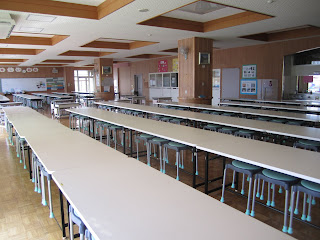Schools are some of the best places to really study a country’s culture. After all, schools are where culture is taught to children. Yes, reading, writing, and ‘rithmatic are taught, too, but one of the most important jobs a school has is to pass along societal habits, norms and values to their students. Teaching in a Japanese school allows me a rare insight into these social details, and I thought I’d share some of the more interesting discoveries I have made. Today, we’ll look at school lunches.
Lunch is a big affair, with all of the students in the school gathering in the cafeteria. In American schools, lunch is usually split, with the younger students eating earlier and the older students eating later. Here, all the students eat together, and each has a special table for their age and class. Teachers eat with the students as well, about two teachers for every table. Lunch is carefully planned around nutritional standards and usually consists of rice (or two pieces of bread), meat (usually fish), soup, some sort of side dish (sometimes a noodle or mushroom salad), and always a carton of milk.
Each class has a few students helping to serve lunch, even the first graders. They have white jackets, facemasks, and hairnets that they wear as they serve lunch out to their classmates. For the first grade, the students walk to the serving area, make up a plate, and bring it back to give to another student. Then, other students walk up and make a plate and bring it back to give to someone else, so that each student is being served by another student. The second graders seem to make their own plates, so it may just be a tradition for the first graders.
The entire time this is happening, soothing, happy is music is being played (I distinctly heard ‘When You Wish Upon a Star’, so think music along those lines). Teachers walk around with the extra food and students raise their hands to indicate that they would like more of a certain dish and the teachers dole it out. Once everyone has their lunch, the music stops and another students stands at the head of the cafeteria and announces what the lunch is and leads the students in saying ‘itadakimasu’. Literally translated, this means ‘I humbly receive’, but it basically means ‘let’s eat’ or ‘bon appetite’. At this point, the students and teachers begin to eat, mostly in silence (though, given that these are kids we’re talking about, there is a fair amount of whispering). All in all, the lunches are tasty, though sometimes the way they look can be a little off putting (whole fish, baby fish, goopy soup, etc.). The children are diligent in cleaning their plates, and I haven’t seen a single student not finish their lunch. The students are also very neat while eating, pulling out their personal handkerchiefs or tissues to clean up any spills. The most adorable example of this was when one of the students (a first grader) dropped two pieces of rice between his tray and his neighbor’s tray. His neighbor looked at him, pointed to the rice, and the boy quickly picked it up and put it to the side on his tray.
Once about twenty minutes have passed the music begins to play again, signaling that lunch is almost over. About five minutes later another student comes up and announces anything that needs announcing before leading everyone in saying ‘gochisosamadeshita’ or, basically ‘it was a feast’.
The students then stand up and begin organizing the dishes, stacking the bowls and plates, putting all of the empty milk cartons and straws on a tray, the chopsticks on another, and each student takes a stack of dishes or a tray to the cleaning area to deposit. Then, they grab their toothbrushes from the shelf nearby and brush their teeth at the nearby trough sink.
Needless to say, there are a few differences between Japanese and American school lunches. I’d say the main difference is the idea that the students are members of the school, not participants in the school. They are expected to help with lunch, clean up after themselves, and generally respect the school the way they would respect their home. Lunch is very ordered and community minded. Everyone (even teachers) eats the same thing and children don’t have the option of bringing their own lunch. There is very little waste, children finishing their lunches even if they don’t particularly like the food that is being served that day. I love lunch times both because it’s a prime opportunity for people watching, but also because there is a real sense of community. The kids are also ridiculously cute, chattering away to me in Japanese as I nod and smile and try to get my points across with charades.
So far, I'm enjoying the lunches, though I seem to have had better luck with food than some of the other JETs. I'll detail the rest of my adventures in school culture as I go, but this has been the most startling thus far.




























